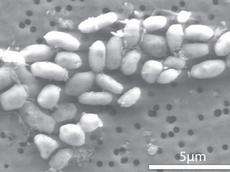Extra-terrestrial life remains terrestrial

(Phys.org) -- A study by ETH Zurich researchers demonstrates that the “arsenic bacterium” postulated as a spectacular new life form by NASA in 2010 cannot do without phosphorus. This demonstrates the continuing validity of a central dogma of biology.
It was a sensation: the fact that a bacterium uses toxic arsenic instead of phosphorus as a vital building block completely turned on its head our understanding of life as we know it. It also fed speculation as to what extra-terrestrial life might look like.
The scientific community was correspondingly striked when NASA announced in a press conference in 2010 that a team of biologists from the US Geological Survey, the American geological research agency, had found an extraordinary microorganism called “GFAJ-1” in the mud of Lake Mono in California – a lake that has extremely high saline and arsenic contents and thus displays unusual conditions for normal terrestrial life. Obviously not only was this newly discovered mite unharmed by arsenic, but was also able to use the poisonous semimetal instead of phosphorus to build macromolecules, and in particular the genome molecule DNA.
Arsenic as element of organic life?
The US scientists thereby overturned a biological dogma – namely that all organic life on Earth, from the tiniest microorganism to humans, is assembled from six basic building blocks: carbon, hydrogen, oxygen, nitrogen, sulphur and phosphorus.
Phosphorus and arsenic are indeed chemically very similar, which is why it is not a problem for the toxic element to “infiltrate” into organs and cells. Once there, arsenic in compound form unleashes its destructive effects. Are we now to believe that this highly poisonous substance can suddenly replace phosphorus as a seventh fundamental element in a bacterium, and even allow the organism to grow? A daring thesis that brought many sceptics up in arms.
More detailed insight into its metabolism
The research group led by Julia Vorholt, Professor at the Institute of Microbiology, has now refuted the “arsenic bacterium” thesis in a paper published in the scientific journal “Science”. The ETH Zurich team of microbiologists and analytical chemists gave the first detailed systematic insight into the microorganism’s metabolism.
Using high-resolution mass spectrometry and a newly-developed computer-assisted analysis that simulates all the possible combinations of biomolecules containing arsenic, the researchers made a specific search for arsenic compounds inside the cells of GFAJ-1 bacteria. By doing this they actually did find a few sugar molecules containing arsenic. But: Tobias Erb, ETH Zurich Fellow and first author of the paper, explains that “Contrary to the assumption by the NASA scientists, the arsenic sugar is not actively formed by the bacterium itself, but involves a spontaneous process instead.”
In further experiments based on so-called isotope labelling studies, Julia Vorholt, Tobias Erb and Senior Researcher Patrick Kiefer also showed that the “arsenic bacterium” has a functioning phosphate metabolism, whereas they were unable to find any evidence of metabolic activity by the arsenic sugar. The result from Zurich is that “Therefore there are no indications that GFAJ-1 grows with the assistance of biomolecules containing arsenic, or that it uses them actively as cell building blocks.”
It’s impossible without phosphate
Vorholt and her team, in collaboration with ETH Zurich Professor Detlef Günther and Senior Researcher Bodo Hattendorf, who are both trace element and microanalysis experts at the Laboratory of Inorganic Chemistry, also showed that the robust microbes accumulates phosphate extremely efficiently from the environment. Julia Vorholt says “This ability enables the bacterium to have enough phosphate available to synthesise the most important vital building blocks in spite of the high ambient concentrations of arsenic.” She says the arsenic bacterium’s main DNA strands, the so-called genetic information backbone, also consist of phosphate, not of the toxic semimetal. “We were unable to detect any traces of arsenic whatsoever in the DNA strands.”
Traces obviously underestimated
Finally the ETH Zurich scientists also looked more closely at the NASA data published in Science in 2010. Very tiny traces of phosphate were also present in the nutrient medium when the bacterium was grown in this study. These were obviously sufficient for the bacterium’s growth. The team of authors at ETH Zurich suspect that the NASA scientists probably underestimated the traces of phosphate.
In view of these comprehensive results, the five researchers conclude that the central dogma of biology still remains valid. The debate as to whether life on Earth is possible beyond the six known fundamental elements must probably be regarded as closed until there is proof to the contrary.
More information: Erb TJ, Kiefer P, Hattendorf B, Günther D, Vorholt JA. GFAJ-1 is an arsenate-resistant, phosphate-dependent organism. Science, published online 8 July 2012. DOI:10.1126/science.1218455
Journal information: Science
Provided by ETH Zurich




















